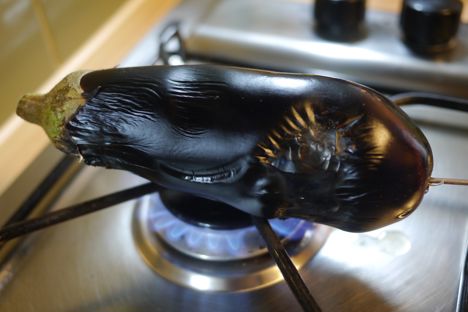The aubergine originally hails from Southeast Asia but is now grown all over the world. Nowadays, the biggest producer is China, which produces over half of all aubergines. Whilst some aubergines are grown in the UK, they prefer warmer climates so the yield is small, but you can find them from May to September. Aubergines are readily available from Italy, Spain and Holland the rest of the year. The first record of aubergines in the UK is from the early 1600s.
Aubergines are not high in any particular vitamins or minerals but they are low in fat and calories. They also make a good substitute for meat in all sorts of dishes. The most popular type of aubergine in the UK is the large purple variety called ‘black beauty’, but there are many different types ranging including white, the striped ‘graffiti’ aubergine, green and yellow. Japanese aubergines are long and very thin, the Indian variety is small and squat and the Thai version is green, the size of a pea and very bitter.
When buying aubergines, look for smooth, glossy skins without blemishes. Feel the weight of the aubergine; it should be quite heavy. If it is light then it usually means it is quite old and woody. Aubergines will keep happily in the salad drawer of the fridge for five to six days – just make sure they are not squashed in as they bruise quite easily.
How to cook aubergine
Some believe that it is necessary to salt aubergine before cooking as it draws out the bitter flavours of the fruit. This used to be the case, but modern varieties of aubergine are a lot less bitter than they used to be. Salting does however draw out moisture from the aubergine which makes it firmer and means it will absorb less fat when cooking, which is useful when frying.
Aubergine can be cooked in a number of ways, with or without the skin. The skin may become tough on larger aubergines, so should be peeled away with a peeler or small knife.
Try baking whole aubergine in the skin and scooping out the flesh to make a purée or dip such as imambiyaldi or baba ganoush or even an aubergine caviar, as Michael Wignall serves with roast turbot. You could also stuff the aubergine before baking; try Food Urchin’s Aubergine stuffed with Quorn ragu and topped with Parmesan, ricotta and lemon zest, or Alfred Prasad’s delicious Smoked aubergine.
Aubergine can be diced up and fried before being added to a dish. It is a main component in ratatouille, which Pascal Aussignac serves with a grilled rack of lamb. Simply dice with or without skin depending on your preference and fry in a hot pan with a good amount of oil. The aubergine will continue to soak oil up as it cooks.
For a crisp aubergine try deep-frying – Nuno Mendes coats his aubergine in rice flour and serves it with salmon and crispy skin. Scott Hallsworth deep-fries his aubergine before coating with a sticky miso-based dressing and grilling to create the traditional Japanese dish of Nasi Dengaku.
Due to its natural smokiness, aubergine is particularly well suited to grilling. Sliced thinly and coated with a little oil and salt, aubergine takes just a few minutes to cook and makes a great vegetarian option at a barbecue. Alfred Prasad grills aubergine and stuffs it with quinoa, paneer and vegetables in his Grilled aubergine rolls.
When cooked whole on the barbecue aubergine takes on the charred flavour from the skin being burnt. The flesh can then be scooped out to make a smoked aubergine purée or baba ganoush. If you don't have a barbecue the same result can be gained by cooking the aubergine over an open flame on the hob until the skin has blackened.
What does aubergine go with?
Aubergine is widely used in European and Middle Eastern cuisine, with the most popular dishes being the Greek moussaka closely followed by the Parmigiana. Try Marcello Tully’s easy Aubergine Parmigiana for a simple midweek meal, or Francesco Mazzei’s Ciambotta di verdure, which combines aubergines with other Italian vegetables and eggs all baked in a loaf of crusty bread – great for a picnic.
Get in touch
Please sign in or register to send a comment to Great British Chefs.



